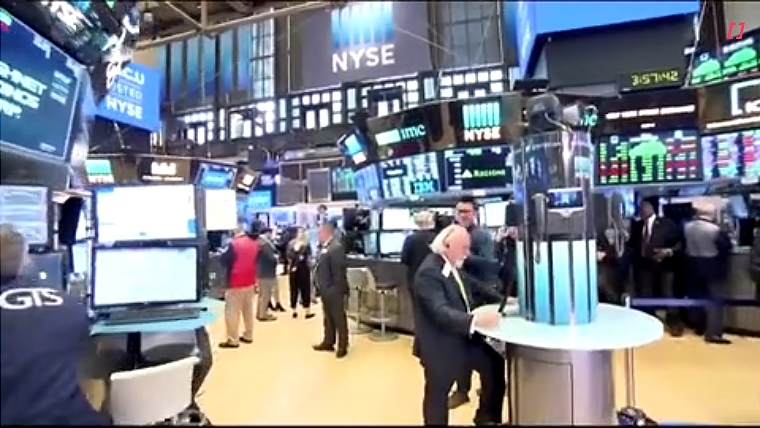
Without any obvious triggers, it has been a bad night for investors, with lower US and European equities, higher global rates and even gold prices are notably weaker. The USD is broadly stronger, and the NZD has fallen 1% from the NZ close to 0.5740.
After a strong open at a fresh record high, the S&P500 has fallen and the market is currently down 0.5%. Newsflow has been light and it’s probably just a case of some profit taking after the record-breaking run. The Euro Stoxx 600 fell 0.4% while yesterday Japan’s Nikkei index closed up 1.8% to a fresh record, buoyed by expectations of more supportive policy settings under new leadership and the weaker yen.
Global rates have pushed higher with US Treasury yields up 2-3bps and similar moves across Europe. The 10-year rate is currently 4.14%. Over the past three weeks it has traded a narrow range of just 12bps. Nothing to see here.
NY Fed President Williams gave a wide-ranging interview with the NY Times and he said, “the risk of a further slowdown in the labour market is something I’m very focused on”. He didn’t directly answer a question on whether he supported two more rate cuts this year, but he said his own view is that “we would have lower rates this year, but we’ll have to see exactly what that means”. Looking further ahead he said we are on a journey back toward neutral and in his view the neutral rate is still relatively low, probably below 1% (in real terms). His comments were seen as relatively dovish, but a fall small in rates and the USD after their publication didn’t last long.
The USD is broadly stronger, with the DXY index up over 0.5% to a fresh two-month high, continuing a recent spurt. Yesterday we mentioned more bullish sentiment for the big dollar, as conveyed by bets in the options market. This is particularly the case for EUR and JPY, where political risk has remerged as a theme. EUR traded below 1.1550 overnight, far cry from a few weeks ago when it looked on track to steam up through 1.20.
JPY has weakened every day since Takaichi was elected as the new LDP leader and soon to become the next PM, although the LDP has yet to come to an agreement with its key coalition partner Komeito. Takaichi made some market-relevant comments on a live TV broadcast in Japan. She said, “there’s no immediate need to revise the BoJ accord”, referring to the joint statement by the government and BoJ signed in 2013 that pledged to overcome deflation”. She added that a weak yen has both merits and demerits and had no intention of triggering an excessively weak yen. She also said the government and BoJ mush work together on economic policies, but it is up to the BoJ to decide on the method of implementing monetary policy and she is not in a position to comment on rate hikes.
Her comments drove about a 60pip plunge in USD/JPY to a low of 152.15 but within half an hour the move had been fully reversed. USD/JPY is back up through 153.
CAD has weakened to its lowest level since April, with USD/CAD blasting up through 1.40. The AUD has weakened to around 0.6550 and the NZD has fallen 1% since the NZ close to 0.5745 – the fall coming after an encouraging lift to over 0.58 yesterday afternoon, above the level prior to the RBNZ’s dovish policy update on Wednesday. Over the last few hours, a base has been forming close to 0.5740 and Wednesday’s six-month low of 0.5737 hasn’t been breached, as at the time of writing.
With the big dollar in the driving seat, NZD cross movements have been relatively small, with the largest move being NZD/JPY falling back below 88.
Spot silver prices surged to a record high of USD51.23 per ounce before falling back below USD50, continuing a strong run that has accelerated over the past few months. The precious metal is up over 70% year-to-date, significantly beating the strong run in gold prices this year. The move has been driven by similar forces to gold, such as the fiat money debasement trade, as well as meeting strong demand for industrial purposes. Gold is having a breather today, falling over 2% to USD3950 after the recent surge through USD4000.
In the domestic rates market, there was continued positioning adjustments in the wake of Wednesday’s RBNZ update. The market was clearly short NZGBs heading into the weekly bond tender and the event met strong demand, particularly for the 2034s, which attracted $1.09b in bids for the $175m on offer. Yields closed the day down 2-8bps across the curve, with a flattening bias, excluding the ultra-long bonds. The 10-year rate fell 7bps to 4.11%.
The move spilled over into the swaps market, with the 10-year rate down 5bps to 3.64% while the 2-year rate fell just 1bp to 2.55%. Cross market outperformance remained, with the NZ-Australian 2-year swap spread falling to a fresh 13-year low of minus 92bps. The last time the rate spread was this low, NZD/AUD was trading below 0.80. Ouch.
In the day ahead, NZ manufacturing PMI data will be released, ahead of testimony in front of lawmakers by RBA Governor Bullock. Tonight sees the release of Canada’s employment report and the University of Michigan consumer survey.
Daily exchange rates
Select chart tabs
Jason Wong is the Senior Markets Strategist at BNZ Markets.

We welcome your comments below. If you are not already registered, please register to comment.
Remember we welcome robust, respectful and insightful debate. We don't welcome abusive or defamatory comments and will de-register those repeatedly making such comments. Our current comment policy is here.